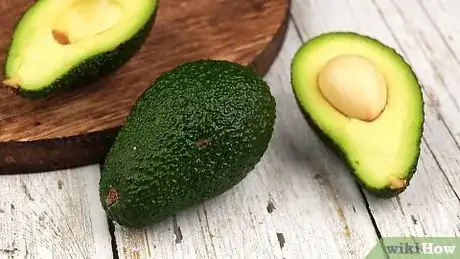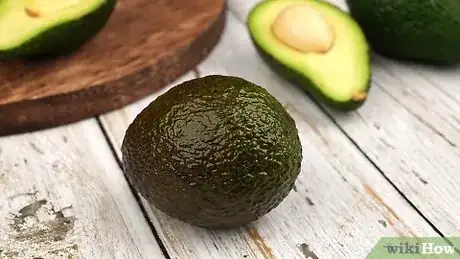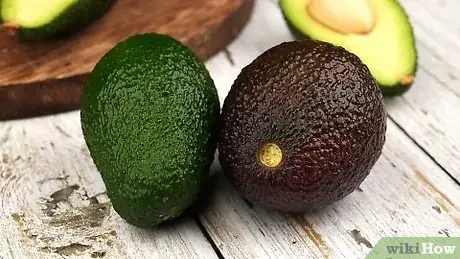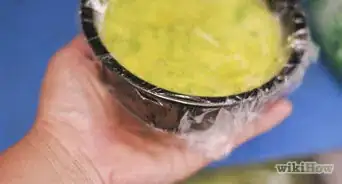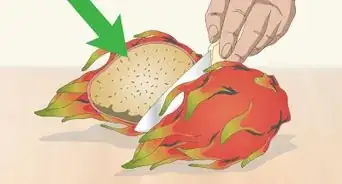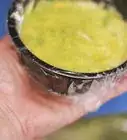This article was co-authored by Jennifer Levasseur. Chef Jennifer Levasseur is a Personal Chef and the Owner of The Happy Cuisiniere based in Breckenridge, Colorado. She has over 12 years of culinary experience and specializes in Mountain and Contemporary Rustic cuisine. Moreover, she can craft dishes and modify menus to accommodate dietary restrictions, such as gluten-free, vegetarian, vegan, pescatarian, and dairy-free diets. In addition to a Bachelor’s degree in Marketing and Management from the University of Houston, Chef Jennifer holds Associate’s degrees in Culinary Arts and Baking & Pastry Arts from Houston Community College.
wikiHow marks an article as reader-approved once it receives enough positive feedback. In this case, 100% of readers who voted found the article helpful, earning it our reader-approved status.
This article has been viewed 415,689 times.
If you love a tasty bowl of guacamole or plate of avocado toast, you know how delicious avocados can be. But the key to any recipe is starting with good avocados. It can be tricky to pick out the best fruit when you're at the grocery store or farmer's market, but once you know what to look for and how to determine the best level of ripeness for your needs, you can always come home with a good avocado.
Steps
Testing Avocadoes for Ripeness
-
1Pay attention to the avocadoes' color. The first thing that you'll probably notice about avocados at a store is their color. Ripe avocados are typically a dark, almost black color with hints of green when they're ripe. If you want to use the avocado as soon as you get home, choose one that is dark. If you plan to use one in a couple of days, select one that's more green.[1]
- Some varieties of avocado such as the Fuerte, Ettinger, Reed, and Sharwill stay green when they are ripe, so it's important to know the type of avocado that you're looking at.
- Keep in mind that color isn't the only factor that you should consider when looking for a ripe avocado. Always test it by touch too.
-
2Squeeze the avocados. If an avocado looks ripe, you should still feel it to test its ripeness. Hold it in the palm of your hand, and squeeze gently. A ripe avocado should yield to firm, gentle pressure, but shouldn't feel overly soft or mushy.[2]
- If an avocado feels firm or hard, it isn't ripe yet. Purchase it only if you plan to use the fruit several days in the future.
- If an avocado feels soft, it's overripe so you should avoid it.
- The harder that an avocado is, the longer that it will likely take for it to ripen.
- If you're purchasing several avocados, it's a good idea to choose them at various stages of ripeness. That way, you'll have some that you can use right away, some that you can use in a couple of days, and some that you can use four or five days in the future.
Advertisement -
3Check the avocadoes' skin. In addition to the color of the avocado's skin, you should examine its texture. The skin should be slightly pebbled, but make sure that there are no large indentations that may indicate the fruit's been bruised.[3]
-
4Examine the avocados' stems. To ensure that the avocado you're choosing is ripe and creamy on the inside, peel back the small stem or cap at the top. If the area underneath is green, the avocado is good to buy. If the area is brown, the avocado is overripe so it's best to avoid it.[4]
- Keep an eye out for mold as well. If the stem area is black or dark brown, the fruit is likely moldy.
Choosing the Right Avocado Variety
-
1Select an avocado-based on your flavor preference. While all avocados have a similar taste, there are subtle differences in their flavor that may make you prefer one over another. Some have a nutty flavor, while others have a lighter taste. Choose an avocado based on what flavor will work best for your recipe or use.[5]
- Hass, Lamb Hass, Gwen, Reed, or Sharwil avocados have a creamy, nutty flavor.
- Bacon and Zutano have a lighter taste.
-
2Choose an avocado-based on its peeling characteristics. Some avocadoes are easy to peel, while others require a little more effort to remove the skin. If you're in a hurry, purchase avocados that are easier to peel to save yourself some time. If you don't mind putting a little more work into peeling the fruit, you can opt for any variety.[6]
- Pinkerton avocados are the easiest to peel, but Bacon, Fuerte, Hass, and Gwen don't pose many difficulties either.
- Zutano avocados are moderately easy to peel.
- Ettinger avocados are the most difficult type to peel.
-
3Buy an avocado-based on its oil content. Some varieties of avocado have more oil in them than others, which means they have a higher fat content. If you want to maintain a healthy low-fat diet, choose a variety that has a lower oil content.[7]
- Avocados with the highest oil content are the Hass, Pinkerton, Sharwil and Fuerte varieties.
Storing and Ripening Avocados at Home
-
1Keep unripened avocados in a paper bag. If you purchase an avocado that hasn't ripened yet, you can leave it out on your counter to ripen in four to five days. To help the fruit ripen more quickly, place it in a brown paper bag with an apple or banana, which release ethylene gas that helps the avocado ripen in two to three days.[8]
- Keep the paper bag with the avocados out of direct sunlight to ensure that they don't become overripe.
- When you remove the avocados from the bag, test their ripeness by pressing against the skin lightly. It should be tender but not mushy.
- If you want to soften avocados quickly, then put them in the freezer and then thaw them right away.
-
2Store whole, ripe avocados in the refrigerator. If you bring ripe avocados home from the grocery store or ripen them in a paper bag but don't plan to use them right away, leave them intact and uncut. Store them in the refrigerator for up to three days.[9]
- Because the cold slows down the ripening process, never store unripe avocados in the refrigerator.
-
3Sprinkle cut ripe avocados with lemon juice before refrigerating. If you eat or use half of a ripe avocado and don't plan to finish the rest, you should store it in the refrigerator. However, it's important to squeeze a fresh lemon or lime over it to stop it from browning. Seal it in plastic wrap or an airtight plastic container, and keep it in the fridge for no more than a day.[10]
- You'll have a better chance of keeping the avocado from browning if you leave the pit in it when you cut it.
Community Q&A
-
QuestionWill it make me sick if I eat an avocado that's been in the fridge for 3 days or more?
 Community AnswerNo, it won't. Just make sure it's green or yellow and it doesn't smell bad.
Community AnswerNo, it won't. Just make sure it's green or yellow and it doesn't smell bad. -
QuestionWhat is the redness on the inside of the avocado peel? Some of it is on the avocado. Is it too ripe? Is it okay to eat?
 Community AnswerThat means your avocado is overripe. Use a spoon to remove these parts and eat the green/lightly yellow mushy parts.
Community AnswerThat means your avocado is overripe. Use a spoon to remove these parts and eat the green/lightly yellow mushy parts. -
QuestionHow do you know if an avocado is rotten?
 Maggie PetersonCommunity AnswerRotten avocados are very shrunken and wrinkly in appearance and texture. The insides become so mushy they are like liquid. There also might be mold on the avocado.
Maggie PetersonCommunity AnswerRotten avocados are very shrunken and wrinkly in appearance and texture. The insides become so mushy they are like liquid. There also might be mold on the avocado.
References
- ↑ https://www.avocadocentral.com/how-to/how-to-pick-how-to-buy-avocados
- ↑ https://www.avocadocentral.com/how-to/how-to-pick-how-to-buy-avocados
- ↑ http://www.foodnetwork.com/how-to/packages/help-around-the-kitchen/photos/how-to-choose-store-and-ripen-avocados.html
- ↑ https://www.thekitchn.com/use-this-simple-trick-to-determine-whether-an-avocado-is-ripe-inside-tips-from-the-kitchn-172933
- ↑ http://www.californiaavocado.com/how-tos/avocado-varieties.aspx
- ↑ http://www.californiaavocado.com/how-tos/avocado-varieties.aspx
- ↑ http://www.avocadosource.com/Journals/SAAGA/SAAGA_2014/SAAGA_2014_37_PG_62.pdf
- ↑ http://www.epicurious.com/ingredients/how-to-buy-and-store-avocados-article
- ↑ http://www.epicurious.com/ingredients/how-to-buy-and-store-avocados-article
About This Article
If you're trying to buy a good avocado, test its ripeness by squeezing it gently in your hand to see if it gives slightly. You should also check the color of the fruit's skin, which is usually darker when it's ripe. Avoid avocados with blemishes on the skin, which could be a sign of bruising. If you like a creamy, nutty flavor, look for Hass or Gwen avocados, but choose Bacon or Zutano if you prefer a lighter texture. For tips on storing avocados at home, including where to keep unripened avocados, read on!
